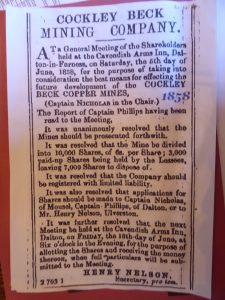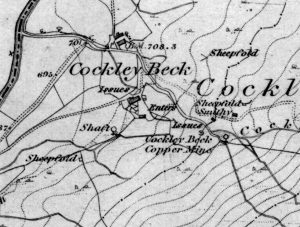June 2019
Seathwaite Dam and the Newfield riots
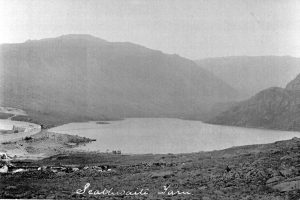
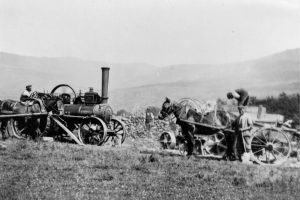
In order to create a source of drinking water for Barrow in Furness, the existing tarn was considerably enlarged with a dam in 1904. The dam had repairs and reconstruction in 2010 and 2018
The dam is almost 400 yards (366 m) long the resulting depth of the tarn being around 80 feet (24 m). Water is not abstracted directly from the tarn, but flows some distance downriver to an off-take weir.
Extracts taken from the Dalton News July 30th 1904
The riot at Seathwaite took place on Monday afternoon July 25th 1904 and resulted in the death of a man named Owen Kavanagh.
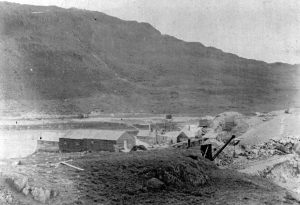
The building of the dam at Seathwaite tarn was for the Barrow Waterworks and the contractors were Messrs Kennedy and Company of Glasgow. In addition to the genuine navvy who goes about from place to place working on such jobs, there are always a lot of men who are really hangers-on.
It appears that a man whom the landlord thought had had enough to drink was asked to leave and a row commenced. The crowd became ugly and threatening. Information shows that the affair was a drunken melee on the part of a dozen hangers on hailing from Millom. Windows were smashed at the Hotel, Church, the vicarage and the school; large stones being pitched through windows on the side next to the highway.
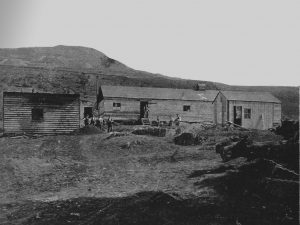
The landlord, his wife and daughter and other occupants were in fear of their lives. A messenger was sent to Broughton for assistance but that was 10 good miles and the landlord in order to defend his life, his hearth and his ho
me took down his gun. In self defence the Landlord Mr Dawson, John Greenhow his barman and Henry Knox Todd fired at the assailants and three were wounded. These men were named Foy, Kinsella and Kavanagh all hailing from Millom. The man Kavanagh died at noon on Tuesday.
Extracts taken from the Dalton News Aug 13th 1904
After due deliberations, the charges against the landlord Mr Dawson, John Greenhow and Henry Todd were dropped and the men discharged.
May 2019
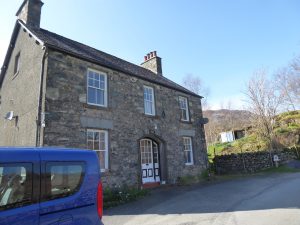
Troutal
There were two farms at Troutal, the second of which was renamed Browside about 1800. The one now known as Troutal was also sometimes known as Lonninside, and also Wayside.
There were Tysons at Troutal from the early 17th century, although their descent is not clear until the 18th. They were closely connected with the Tysons of Tongue House.
Abraham Tyson was admitted to Troutal in 1843 but he must have been under age at the time. He was still living at High Shaw, Millom when he raised £600 by mortgaging Troutal in 1851 and he died in 1860 with the debt still largely unpaid.
Troutal was owned by Edward (c.1830-1911), and then his son the Revd Edward Tyson (1900-1956). In 1958 the widow of the younger Edward sold Troutal to the National Trust.
The present house was built in 1894, and the old house was demolished. It was said to be suitable for a Temperance Hotel or Boarding House when it was advertised to be let in 1895, with a kitchen and dairy, four reception rooms, and eight bedrooms. The builder was a John Tyson.
Between 1930 and 1939 it was leased at a nominal rent to the headmaster of the Liverpool Institute, the Revd H. H. Symonds, and used for school walking parties. During the Second World War it was used by conscientious objectors working for the Forestry Commission. A Youth Hostel, transferred from Dalehead was established there in 1944.
April 2019
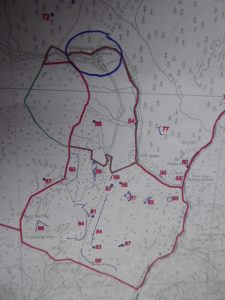
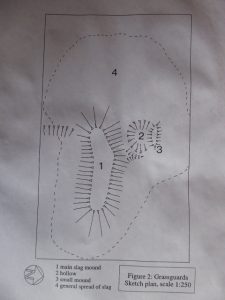
The bloomery , site 67 on the survey, is on Hollin How at GR SD 22511 97229 has been given rating of High for Potential, Value, and Rarity and 1 for Significance
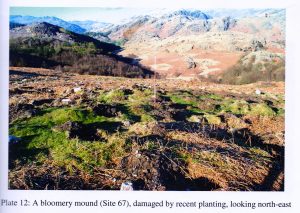
Despite the uncertainty of any features revealed by this survey, Grassguards is nevertheless an important site. The slag mound is of unusually large size and is broadly comparable to the well-known slag heap at Springs, Coniston.
Taking a mean height for the slag mound of 1 metre, the approximate volume of slag at Grassguards is of the order of 270 cubic metres, representing some 250 to 300 tonnes of slag. Though this is less than half of the estimated weight of slag at Springs, it is clear that Grassguards is one of the larger iron-working sites known in Cumbria.
It can be estimated that 250 tonnes of slag could result from some 10,000 smelts. If 250 smelts were carried out each year, this represents some 40 years of continuous production. If two furnaces were being used simultaneously, there could have been 20 years of continuous production.
The iron-workers would have taken advantage of local timber supplies for charcoal making.
March 2019
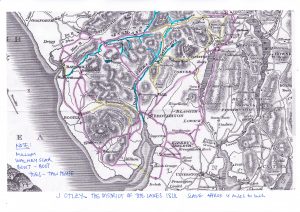
This map was published in 1818 and shows that most of the routes we use today were in place two hundred years ago. Interesting to see that the Park Head Road from Kiln Bank Cross and the Walney Scar Road are given the same rating as the way up the valley beyond Ulpha. The “main” route from Coniston to Ambleside is shown going over High Cross while the current route is only a minor track. It must have been a poor choice to make the climb over to Hawkshead Hill worthwhile.
View the whole of the Lakes in 1818 map
February 2019 is the first!
The copper mine at Cockley Beck: poster 1858 and 6″ OS map 1852
